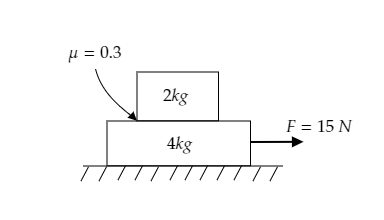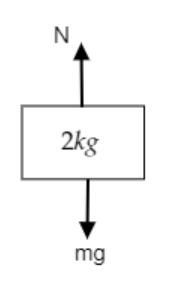Question
Question: Find the frictional force between the two blocks in the given figure. 
A) 6N
B) 17⋅6N
C) 5N
D) 12N
Solution
When the force is applied on the lower block of mass, the upper block will slide only when it receives a force greater than the maximum frictional force acting on it. If the two blocks were to slide then they would have a common acceleration and this would be equal to the acceleration of the lower block in the presence of friction.
Formula Used:
The maximum frictional force acting on a block of mass is given by, fmax=μN where μ is the coefficient of friction and N is the normal force acting on the block.
The common acceleration of a system of two blocks is given by, acommon=m1+m2F where F is the applied force and m1, m2 are the masses of the two blocks.
Complete step by step answer:
Step 1: List the parameters obtained from the figure.
The arrangement of two blocks, one on top of the other, on a horizontal surface is given below.

The force applied to the lower block is given to be F=15N .
The mass of the lower block is mL=4kg and that of the upper block is given to be mU=2kg .
The coefficient of friction is μ=0⋅3 .
Step 2: Express the relation for the common acceleration of the system.
The common acceleration of the given system of two blocks is given by,
acommon=mU+mLF -------- (1)
Substituting for F=15N, mL=4kg and mU=2kg in equation (1) we get, acommon=2+415=2⋅5ms−2
Thus the common acceleration of the system is acommon=2⋅5ms−2.
Step 3: Sketch a figure depicting the forces acting on the upper block and find the maximum friction of the block.

In the above figure, the force of gravity W=mg acts downwards and an equal normal force N acts upwards.
The normal force acting on the upper block will be N=mg=2×10=20N .
Now, the maximum frictional force acting on the upper block is given by, fmax=μN ------ (2)
Substituting for μ=0⋅3 and N=20N in equation (2) we get, fmax=0⋅3×20=6N
i.e., the upper block will slide only when it receives a force greater than fmax=6N .
When the upper block receives this force its acceleration will be amax=mUfmax=26=3ms−2 .
Step 4: Using the obtained value for the maximum friction find the acceleration of the lower block.
As the lower block receives a force F=15N to slide, the force of friction f will try to oppose the sliding.
Hence the total force acting on the lower block in the horizontal direction will be F−f .
The acceleration of the lower block is given by, aL=mLF−f
⇒f=F−(aL×mL) ------- (3)
The lower block moves with the common acceleration of the system i.e., aL=acommon=2⋅5ms−1
Substituting values for F=15N, aL=2⋅5ms−2 and mL=4kg in equation (3) we get, f=15−(2⋅5×4)=5N
Thus the frictional force between the blocks will be f=5N .
So the correct option is C.
Note: If the frictional force between the two blocks f=fmax=6N then the acceleration of the lower block would be aL=415−6=2⋅25ms−2 .
But we know that the acceleration of the lower block will be acommon=2⋅5ms−2 .
So the frictional force between the blocks, f=fmax .
